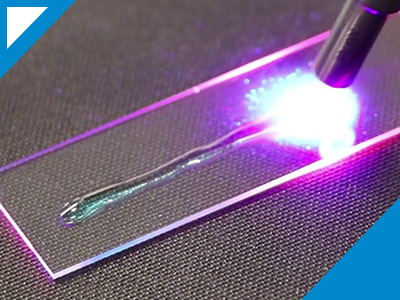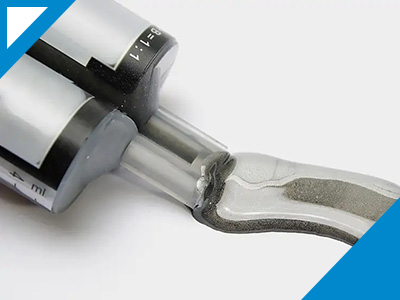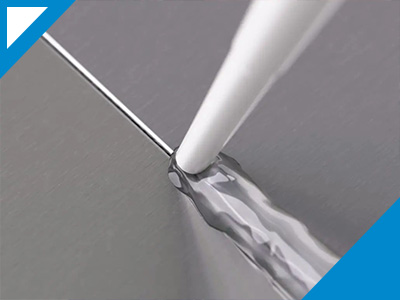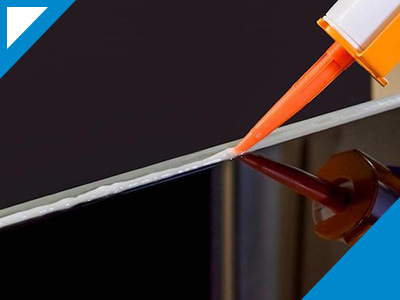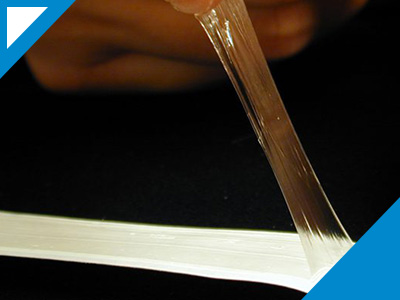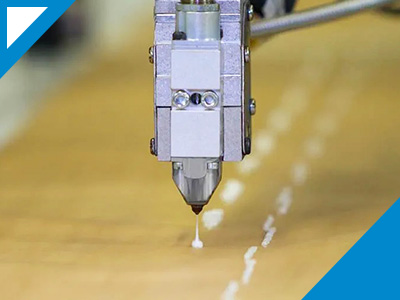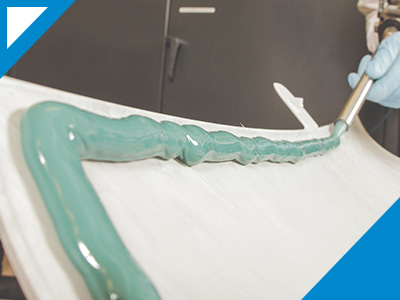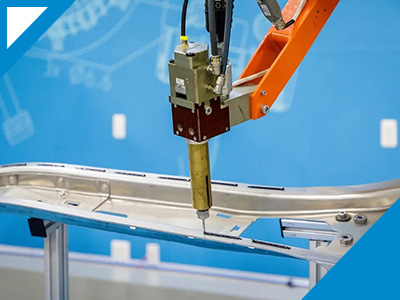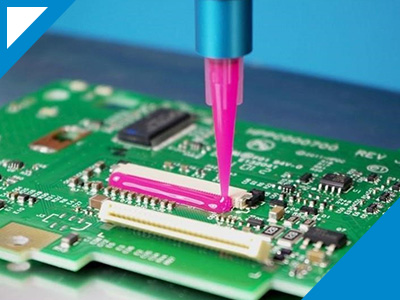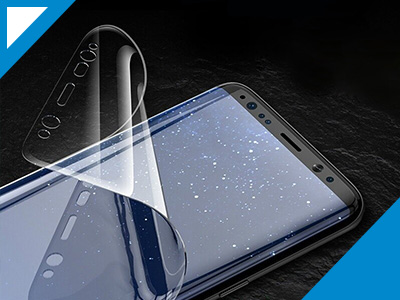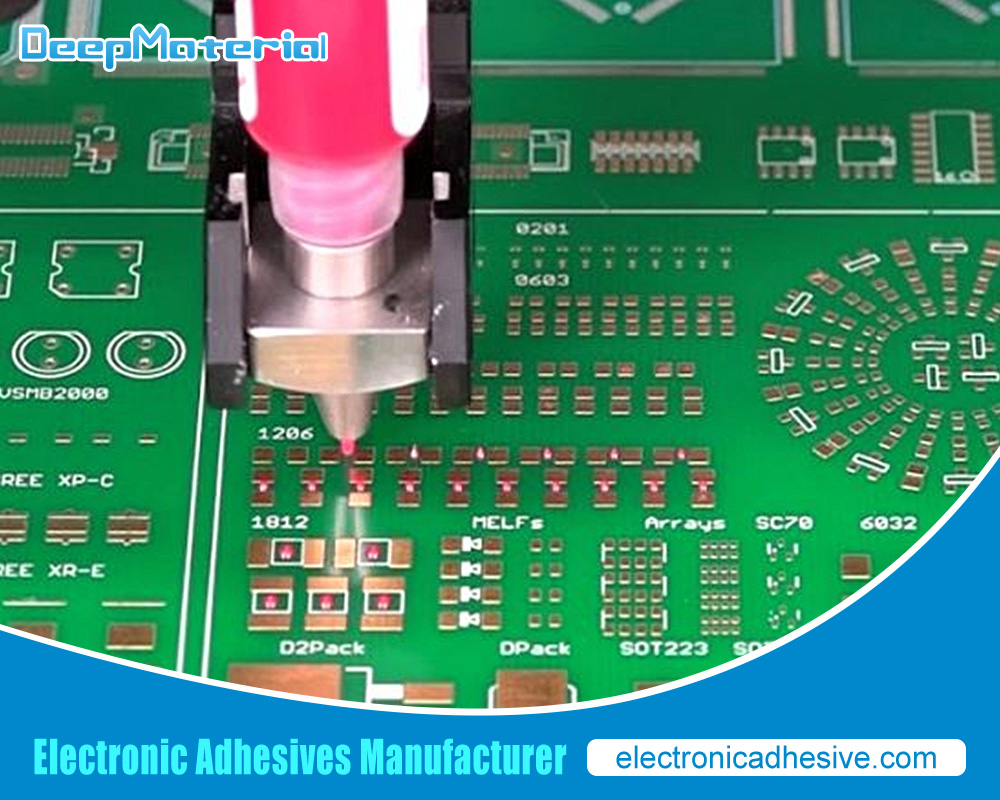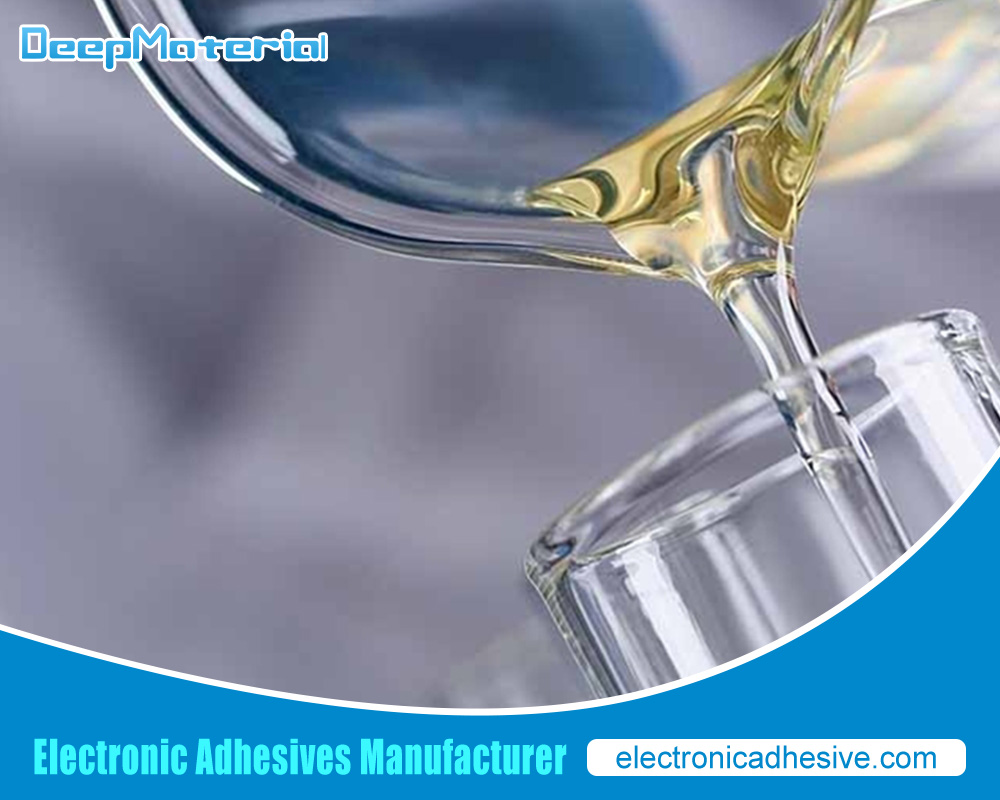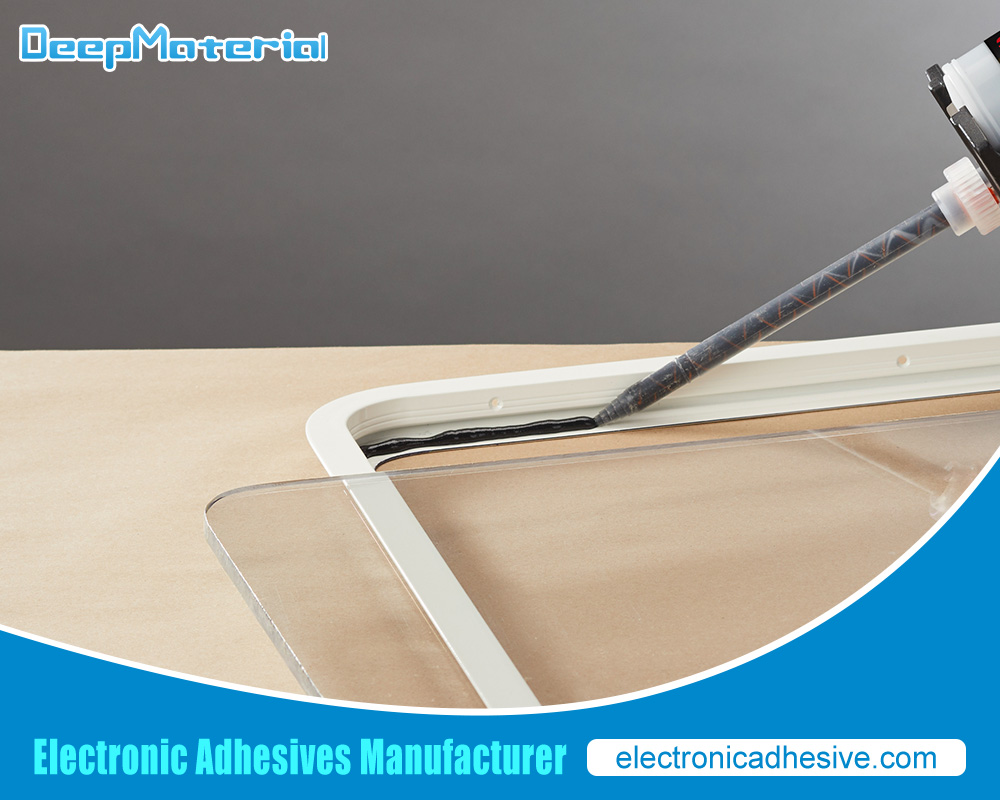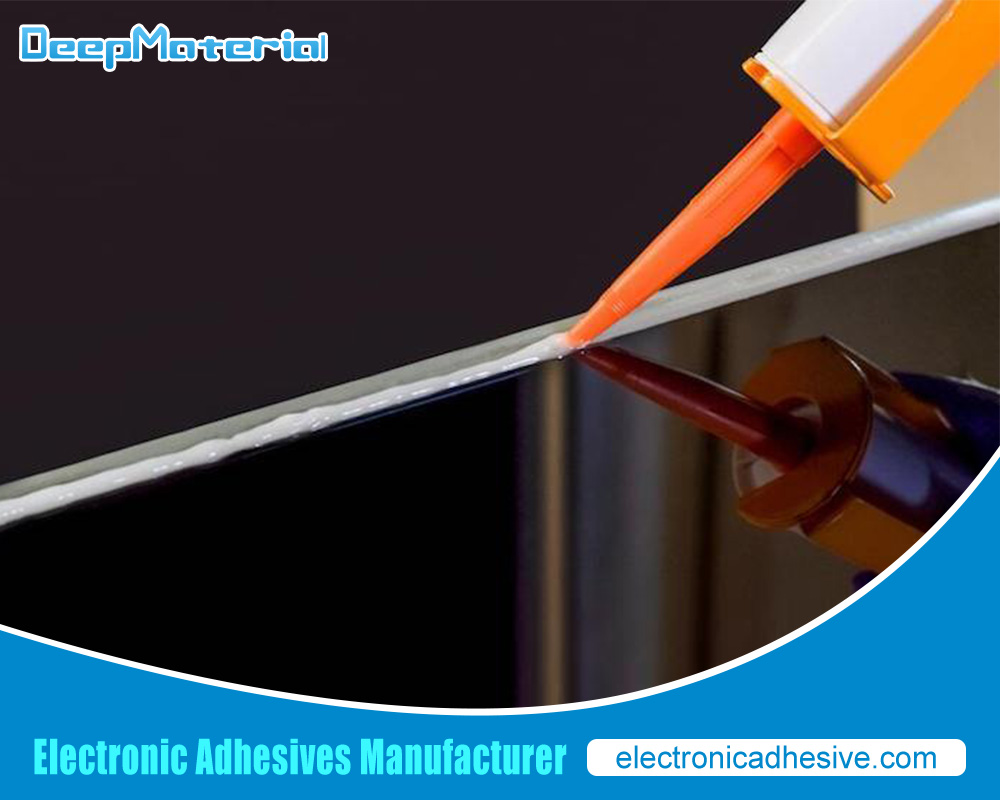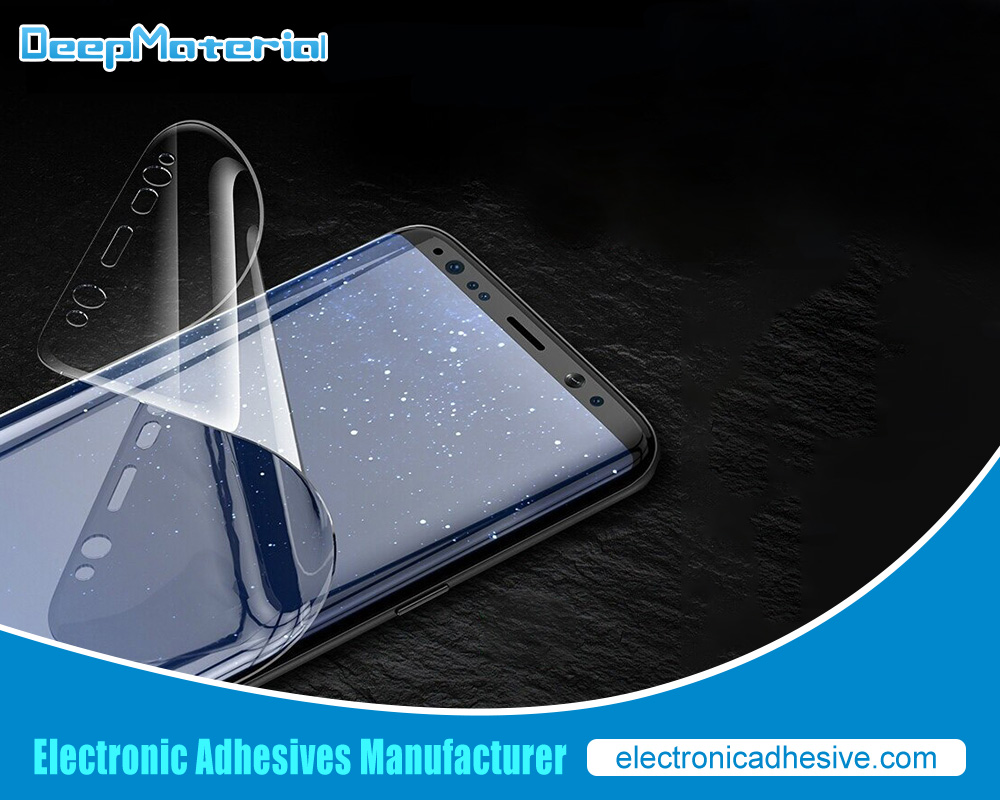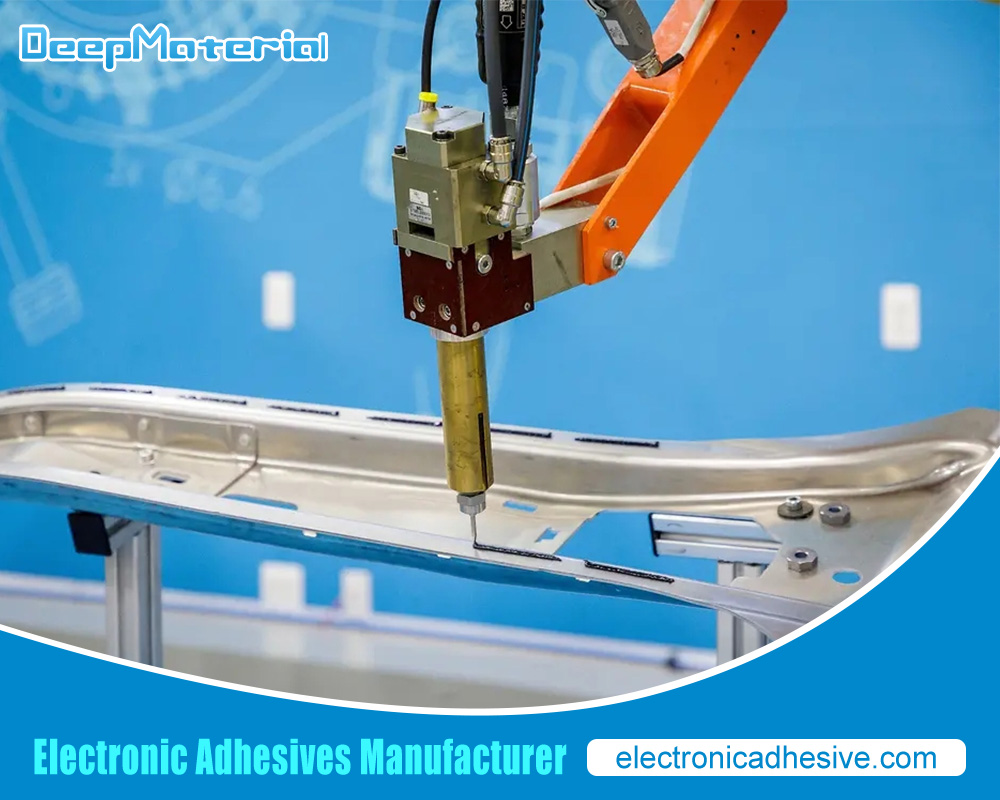OLED Display Module Adhesive

Introduction: The OLED (Organic Light-Emitting Diode) display module has become famous for many electronic devices due to its high contrast ratio, vibrant colors, and thinness. However, one crucial component of OLED display modules that is often overlooked is the adhesive that holds the module in place. A suitable adhesive can improve the durability and reliability of the device and enhance the display’s performance. This article will explore the importance of OLED display module adhesive and its different types and applications.
What is OLED Display Module Adhesive?
The OLED display module is a specialized adhesive used to manufacture and assemble OLED (Organic Light-Emitting Diode) display panels. It plays a crucial role in bonding different display module layers together, providing structural integrity, electrical connectivity, and optical performance.
OLED displays are known for their thinness, flexibility, and superior picture quality. They contain multiple layers, including the substrate, organic coatings, electrodes, and encapsulation. These layers need to be securely bonded together to ensure the display’s proper functioning and protect it from external factors such as moisture, dust, and physical damage.
The OLED display module adhesive is designed to meet the specific requirements of OLED displays. It is typically a transparent or translucent adhesive material that allows light to pass through without significant interference. This is crucial for maintaining the display’s optical properties, including brightness, color accuracy, and contrast.
One of the critical functions of the adhesive is to provide electrical connectivity between different layers of the display module. It ensures proper contact between the electrodes and the organic layers, allowing the flow of electric current necessary for the OLED pixels to emit light. This electrical connectivity is crucial for the display to function correctly and produce high-quality images.
Moreover, OLED display module adhesive also provides structural support to the delicate OLED layers. The adhesive helps bond the layers together, preventing delamination and ensuring the display remains intact even under mechanical stress or temperature variations. It enhances the overall durability and reliability of the display module.
Another essential characteristic of OLED display module adhesive is its compatibility with the materials used in the display module. It should be able to adhere to various substrates, including glass and flexible plastic, as well as different types of electrode materials, such as indium tin oxide (ITO) or graphene. The adhesive should also exhibit good adhesion to the organic layers, preventing any separation or degradation over time.
In addition to its adhesive properties, OLED display module adhesive should possess other desirable characteristics. It should have good thermal stability to withstand the heat generated during the operation of the display. It should resist moisture and environmental factors to provide long-term protection to the OLED layers. Furthermore, it should have a low outgassing rate to minimize any potential impact on the display’s performance or longevity.
Overall, OLED display module adhesive is a critical component in manufacturing OLED displays. Its transparent and electrically conductive properties and ability to bond different layers together contribute to the functionality, durability, and optical performance of OLED displays, enabling the production of high-quality and visually stunning devices.
The Role of Adhesive in OLED Display Modules
Adhesive plays a crucial role in OLED (Organic Light Emitting Diode) display modules, contributing to their structural integrity, optical performance, and overall reliability. OLED technology has gained significant popularity due to its advantages, such as high contrast ratio, wide color gamut, fast response time, and thin form factor. Adhesive materials used in OLED display modules serve several vital functions outlined below.
Structural Integrity: Adhesive is utilized to bond various layers and components of an OLED display module together, ensuring their stability and mechanical strength. These layers typically include the glass or plastic substrate, the transparent conductive layer, the organic layers responsible for light emission, and the encapsulation layer. Adhesive materials provide a strong bond, preventing delamination and maintaining the structural integrity of the display module.
Optical Performance: Adhesive materials also contribute to the visual performance of OLED display modules. They are designed to have high transparency and low haze, minimizing light scattering and maximizing the light emitted from the OLED pixels. This results in improved image quality, vibrant colors, and high contrast ratios. Adhesive materials with excellent optical properties are crucial for achieving optimal display performance.
Thermal Management: OLED displays generate heat during operation, and efficient heat dissipation is essential to prevent overheating and ensure long-term reliability. Adhesive materials used in OLED modules often have good thermal conductivity properties. They facilitate heat transfer from the OLED layers to other components, such as heat sinks or the device housing, effectively dissipating the generated heat and maintaining the OLED’s operating temperature within acceptable limits.
Environmental Protection: OLED displays are sensitive to moisture and oxygen, which can degrade their performance and reduce lifespan. Adhesive materials are vital in encapsulating the OLED layers, forming a protective barrier against environmental factors. These materials are engineered to have high barrier properties, minimizing the ingress of moisture and oxygen into the display module. By providing adequate ecological protection, adhesive materials contribute to the longevity and reliability of OLED displays.
Manufacturing Process: Adhesive materials also facilitate the assembly process of OLED display modules. They are formulated to have appropriate rheological properties, enabling precise dispensing and uniform bonding during manufacturing. Adhesives with suitable cure kinetics allow efficient processing, reducing production time and cost.
Adhesive materials are critical components in OLED display modules, serving multiple functions. They provide structural integrity, optimize optical performance, assist in thermal management, offer environmental protection, and support manufacturing. With ongoing advancements in OLED technology, developing specialized adhesive materials tailored for OLED displays will continue to play a pivotal role in enhancing their performance, reliability, and longevity.
Benefits of Using High-Quality Adhesive for OLED Displays
Using high-quality adhesive for OLED displays offers numerous benefits, contributing to the devices’ overall performance, durability, and user experience. Let’s explore some of these advantages:
- Enhanced Display Quality: High-quality adhesive materials are designed to have excellent optical properties, such as high transparency and low haze. Manufacturers can ensure minimal light scattering and maximum light transmission through the OLED layers by using these adhesives. This results in improved display quality, including vibrant colors, high contrast ratios, and sharp image rendering.
- Improved Structural Integrity: OLED displays consist of multiple layers that must be securely bonded together. High-quality adhesives provide superior bonding strength, ensuring the structural integrity of the display module. They effectively prevent delamination and minimize the risk of damage due to mechanical stress, such as impacts or flexing. As a result, the display module remains intact and durable even under challenging conditions.
- Enhanced Reliability: OLED displays are susceptible to environmental factors such as moisture and oxygen. High-quality adhesive materials are specifically formulated to have excellent barrier properties, creating an effective encapsulation layer that protects the OLED layers from moisture and oxygen ingress. This barrier prevents degradation and extends the lifespan of the OLED display, resulting in improved reliability and longevity.
- Efficient Thermal Management: OLED displays can generate heat during operation, and efficient thermal management is crucial to prevent performance degradation or premature failure. High-quality adhesives often have good thermal conductivity properties, facilitating the effective transfer of heat away from the OLED layers. This helps to maintain the display at optimal operating temperatures, ensuring stable performance and prolonging the lifespan of the OLED device.
- Seamless Integration: High-quality adhesive materials are engineered to have suitable rheological properties, making them easy to apply and ensuring uniform bonding across the OLED display module. These adhesives provide excellent wetting characteristics, enabling precise dispensing and minimizing the risk of voids or inconsistencies in the bonding. This seamless integration contributes to the overall aesthetics and functionality of the OLED device.
- Manufacturing Efficiency: High-quality adhesives can enhance the manufacturing process of OLED displays. Their formulation allows for efficient curing, reducing production time and cost. Bonds with optimized cure kinetics enable faster assembly, higher production yields, and streamlined manufacturing operations.
Factors to Consider When Choosing OLED Display Module Adhesive
When choosing an OLED display module adhesive, several essential factors must be considered to ensure optimal performance and durability. Here are some key considerations to keep in mind:
- Optical Clarity: OLED displays require a high level of optical clarity to maintain the visual quality and brightness of the screen. The adhesive should have excellent transparency properties, minimizing any impact on the display’s visibility.
- Thermal Conductivity: OLED displays generate heat during operation, and efficient heat dissipation is crucial to prevent damage and maintain performance. The adhesive should have good thermal conductivity properties to transfer heat away from the display and dissipate it effectively.
- Adhesion Strength: The adhesive should bond strongly between the display module and the substrate or cover glass. It should have sufficient adhesion strength to ensure a reliable and long-lasting connection, even under varying temperature conditions and mechanical stress.
- Flexibility: OLED displays are often used in flexible or curved applications like smartphones or wearable devices. The adhesive should be flexible enough to accommodate the bending or curving of the show without compromising its integrity.
- Moisture and Environmental Resistance: OLED displays are sensitive to moisture and can be damaged if exposed to excessive humidity or liquids. The adhesive should have good moisture resistance properties to protect the display module from environmental factors and ensure long-term reliability.
- Chemical Compatibility: It’s essential to consider the compatibility of the adhesive with other materials used in the display module, such as the cover glass or polarizer. The adhesive should not react or degrade the performance of these components, ensuring a harmonious integration.
- Process Compatibility: The adhesive should be compatible with the manufacturing process of the OLED display module. It should be easy to handle, dispense, and cure for efficient and cost-effective production.
- Aging and Yellowing: Over time, some adhesives may undergo aging or yellowing, which can affect the display’s visual quality. It’s essential to choose a bond that has good long-term stability and does not yellow or degrade over extended periods.
- Electrical Insulation: The adhesive should provide electrical insulation between the conductive components of the OLED display module, preventing short circuits and ensuring reliable electrical performance.
- Regulatory Compliance: To ensure environmental and health safety, consider any relevant industry regulations or standards the adhesive must meet, such as RoHS (Restriction of Hazardous Substances) compliance.
By carefully considering these factors, you can select an OLED display module adhesive that meets the specific requirements of your application, ensuring optimal performance, durability, and visual quality. It’s often advisable to consult adhesive manufacturers or suppliers to obtain detailed technical specifications and recommendations based on your specific needs.
Types of Adhesive for OLED Display Modules
OLED (Organic Light-Emitting Diode) display modules are widely used in various electronic devices such as smartphones, televisions, and wearable devices due to their high contrast, wide viewing angles, and energy efficiency. The assembly of OLED display modules involves using adhesives to bond different layers and components. These adhesives play a critical role in ensuring OLED displays’ performance, durability, and reliability. Let’s explore some common adhesive types used for OLED display modules.
- Optical Clear Adhesives (OCAs): Optical clear adhesives are widely used in OLED displays due to their high optical transparency and excellent bonding properties. They typically bond the cover glass or touch panel to the OLED module. OCAs have a refractive index similar to drinks, which helps minimize light loss and improve display clarity. They also protect against moisture and dust.
- Liquid Optically Clear Adhesives (LOCAs): LOCAs are similar to OCAs in their optical properties. However, they are supplied as a liquid and then cured to form a solid adhesive. LOCAs are commonly used for bonding flexible OLED displays to the cover glass or touch panel. They offer good optical clarity, flexibility, and adhesion strength.
- Conductive Adhesives: Conductive adhesives are used in OLED displays for bonding electrical connections, such as connecting the OLED panel to the driver circuitry. These adhesives contain conductive particles (e.g., silver or copper) that enable electrical conduction while providing adhesive properties. Conductive adhesives ensure reliable electrical connections and can withstand thermal expansion and contraction during device operation.
- Structural Adhesives: Structural adhesives bond various components of OLED displays, such as the frame, backlight unit, and other structural elements. These adhesives provide high bonding strength, durability, and resistance to environmental factors like temperature, humidity, and vibration. Structural adhesives are typically epoxy-based or acrylic-based, depending on the specific application requirements.
- Pressure-Sensitive Adhesives (PSAs): PSAs commonly assemble OLED displays for temporary bonding or positioning. They are typically supplied as adhesive tapes or films and offer instant adhesion upon contact with a surface. PSAs provide good adhesion to many substrates and can be easily removed without leaving residue.
- Thermal Interface Materials (TIMs): TIMs are used in OLED displays to improve heat dissipation and thermal management. They are applied between the OLED panel and the heat sink or cooling system to enhance heat transfer away from the display module. TIMs are often in the form of thermally conductive adhesives or pads that offer both adhesive and thermal properties.
- UV-Curable Adhesives: UV-curable adhesives are used in OLED display assembly processes that require fast curing and high bonding strength. These adhesives are applied in liquid form and then cured rapidly when exposed to ultraviolet (UV) light. UV-curable bonds provide excellent adhesion, fast curing times, and high mechanical strength.
It’s important to note that the specific choice of adhesive for OLED display modules depends on the display structure, materials used, desired optical properties, assembly process requirements, and environmental conditions. Manufacturers select adhesives that meet their specific OLED display applications’ performance, reliability, and manufacturing efficiency criteria.

Conductive Adhesive for OLED Displays
Conductive adhesive plays a crucial role in assembling and manufacturing OLED (Organic Light Emitting Diode) displays. OLED displays are known for their thinness, flexibility, and energy efficiency, making them popular in various electronic devices such as smartphones, televisions, and wearable devices. Conductive adhesives are used in OLED displays to establish electrical connections between different components, ensuring reliable performance and functionality.
The primary purpose of a conductive adhesive in an OLED display is to create electrical connections between the organic layers of the production and the underlying circuitry. Traditional soldering methods are unsuitable for OLED shows due to their sensitivity to high temperatures, which can cause damage or degradation of the organic materials. Conductive adhesives provide a low-temperature bonding solution for efficient and safe assembly processes.
One key characteristic of a conductive adhesive for OLED displays is its electrical conductivity. It should possess good conductivity to ensure efficient transfer of electrical signals between components. Silver-filled conductive adhesives are commonly used in OLED presentations due to their high electrical conductivity. These adhesives contain tiny silver particles dispersed in a polymer matrix, forming conductive paths when applied between two surfaces. The silver particles facilitate the flow of electricity, enabling the proper functioning of the display.
Apart from electrical conductivity, the adhesive should exhibit other desirable properties. One crucial aspect is adhesion strength. The adhesive must form a strong bond between the different layers and components of the OLED display to ensure mechanical stability and long-term reliability. Additionally, the adhesive should have good thermal stability to withstand the operating conditions of the show without degradation or delamination.
Another important property is the adhesive’s viscosity or flowability. The adhesive must be dispensed and spread evenly over the desired area during assembly. It should have a suitable thickness to enable easy application and prevent excessive spreading or dripping. The adhesive should also have a reasonable curing time, allowing for efficient manufacturing processes without unnecessary delays.
Furthermore, the conductive adhesive should exhibit compatibility with the materials used in OLED displays. It should adhere well to various substrates, such as glass or flexible plastic, and work effectively with the organic materials present in the display layers. Compatibility with encapsulation materials is also essential to ensure proper sealing and protection of the OLED structure from environmental factors like moisture and oxygen.
Non-Conductive Adhesive for OLED Displays
While the conductive adhesive is essential for establishing electrical connections in OLED (Organic Light Emitting Diode) displays, the non-conductive adhesive also plays a crucial role in their assembly and manufacturing. Non-conductive adhesives bond and secure various components of OLED displays, providing mechanical stability, protection, and insulation. These adhesives offer several essential characteristics specifically tailored to the unique requirements of OLED technology.
One essential purpose of non-conductive adhesive in an OLED display is to hold the different layers and components together. OLED presentations consist of multiple layers, including the organic emissive, transparent conductive, and substrate. The non-conductive adhesive bonds these layers and creates a robust and reliable structure. It ensures the layers remain securely attached, preventing delamination or separation during operation.
One of the critical properties of non-conductive adhesive is its mechanical strength. The adhesive should provide robust bonding, allowing the OLED display to withstand various mechanical stresses, such as bending or flexing. It helps to enhance the display’s durability, particularly in applications that require flexibility, such as curved or foldable displays.
Another essential characteristic of non-conductive adhesive is its optical clarity. OLED displays produce light through the organic layers, and any hazy or opaque adhesive can obstruct light transmission, negatively affecting the display’s performance. Non-conductive adhesives are designed to have high transparency, ensuring minimal interference with the emitted light and maintaining the display’s brightness and image quality.
Thermal stability is also a crucial consideration for non-conductive adhesives in OLED displays. These adhesives need to withstand the operating temperatures of the presentation without degradation or loss of adhesion. OLED displays can generate heat during operation, particularly in high-resolution or high-brightness applications. The adhesive should have good thermal resistance to maintain its structural integrity and adhesive properties under these conditions.
Additionally, non-conductive adhesives used in OLED displays should be compatible with the materials. They should adhere well to substrates such as glass or flexible plastic, providing a strong bond between different layers. Compatibility with the organic materials in the display is essential to prevent any adverse chemical interactions that could lead to performance degradation or device failure.
Furthermore, non-conductive adhesives should possess suitable viscosity and curing time for efficient manufacturing processes. They should be easy to dispense, spread evenly, and allow for proper alignment of components before curing. The adhesive should also have a reasonable curing time to enable timely production without unnecessary delays.
Thermal Conductive Adhesive for OLED Displays
Thermal conductive adhesive plays a vital role in the efficient heat dissipation and thermal management of OLED (Organic Light Emitting Diode) displays. OLED displays generate heat during operation, particularly in high-resolution or high-brightness applications, and effective heat dissipation is crucial to maintain optimal performance, prevent overheating, and extend the display’s lifespan. Thermal conductive adhesives are specifically designed to provide excellent heat transfer properties while fulfilling the adhesive requirements of OLED displays.
The primary function of thermally conductive adhesive in an OLED display is to facilitate heat transfer from the heat-generating components to the surrounding environment or heat sinks. These adhesives are formulated with thermally conductive fillers, such as ceramic or metallic particles, which improve the adhesive’s ability to conduct heat. The fillers form a conductive path within the adhesive, allowing heat to flow through the adhesive layer efficiently.
One critical characteristic of thermal conductive adhesive is its thermal conductivity. The adhesive should have high thermal conductivity to transfer heat away from the heat source effectively. Typically, thermally conductive adhesives for OLED displays have thermal conductivities ranging from several W/m·K to tens of W/m·K. This ensures efficient heat dissipation, preventing localized hotspots and maintaining uniform temperature distribution across the display.
In addition to thermal conductivity, thermally conductive adhesives should possess other desirable properties. Adhesion strength is crucial to ensure proper bonding between the heat-generating components, such as the display driver ICs, and the heat sinks or the backplane of the display. The adhesive should provide a reliable mechanical bond that can withstand thermal expansion and contraction without compromising the heat transfer path.
Thermal stability is also a vital consideration for thermal conductive adhesives. OLED displays can operate at elevated temperatures, and the adhesive should withstand these conditions without degradation or loss of adhesive properties. It should retain its thermal conductivity and adhesion strength over a wide temperature range, ensuring long-term reliability and performance stability.
Another important property is electrical insulation. Thermal conductive adhesives used in OLED displays should possess good electrical insulation characteristics to prevent short circuits or electrical interference between components. This is particularly important when the adhesive is used close to electrical connections or circuitry.
Furthermore, the adhesive should have suitable viscosity and curing time for efficient manufacturing processes. It should be easy to apply, spread uniformly, and allow for proper alignment of components before curing. The curing time should be reasonable to enable timely production without significant delays.
UV Curing Adhesive for OLED Displays
UV curing adhesive is a crucial component in manufacturing OLED displays, playing a significant role in bonding various layers together and ensuring the display’s performance and durability. OLED (Organic Light Emitting Diode) displays are widely used in applications such as smartphones, televisions, and wearable devices due to their vibrant colors, high contrast ratios, and energy efficiency. UV curing adhesive offers several advantages in the OLED display manufacturing process, making it an ideal choice for achieving high-quality displays.
UV-curing adhesives are polymer-based materials that cure rapidly when exposed to ultraviolet (UV) light. These adhesives typically consist of oligomers, monomers, photoinitiators, and additives. The photoinitiator initiates the curing process, which absorbs UV light and triggers a chemical reaction that leads to rapid polymerization. This allows for quick bonding of OLED layers, reducing production time and increasing efficiency.
One of the critical advantages of UV-curing adhesive is its ability to cure on demand. Unlike other adhesive types that require time or heat, UV-curing adhesives cure within seconds when exposed to UV light. This feature enables faster assembly and higher production throughput, making it well-suited for mass production of OLED displays.
UV-curing adhesives also offer excellent bonding strength and durability. They create strong bonds between different layers of the OLED display, ensuring stability and preventing delamination. The cured sealant provides mechanical support and protects sensitive OLED components from environmental factors such as moisture, dust, and vibrations. This enhances the overall reliability and lifespan of the display.
Furthermore, UV-curing adhesives exhibit a low shrinkage during curing, minimizing the risk of stress-induced damage to the OLED layers. This is crucial because OLED displays comprise delicate organic materials that can be adversely affected by excessive stress or strain. The low shrinkage property of UV curing adhesives helps maintain the structural integrity of the display and prevents performance degradation over time.
Another significant advantage is achieving precise and uniform adhesive layer thickness. UV-curing adhesives can be applied controlled, ensuring consistent and even distribution across the display. This uniformity is vital for maintaining optical clarity, reducing light scattering, and maximizing display performance.
Regarding environmental impact, UV-curing adhesives are generally more environmentally friendly than solvent-based adhesives. They do not release harmful volatile organic compounds (VOCs) during curing and have lower energy requirements due to the rapid curing process. UV-curing adhesives can be formulated to be free of hazardous substances, making them compliant with various environmental regulations.
Epoxy Adhesive for OLED Displays
UV curing adhesive is a crucial component in manufacturing OLED displays, playing a significant role in bonding various layers together and ensuring the display’s performance and durability. OLED (Organic Light Emitting Diode) displays are widely used in applications such as smartphones, televisions, and wearable devices due to their vibrant colors, high contrast ratios, and energy efficiency. UV curing adhesive offers several advantages in the OLED display manufacturing process, making it an ideal choice for achieving high-quality displays.
UV-curing adhesives are polymer-based materials that cure rapidly when exposed to ultraviolet (UV) light. These adhesives typically consist of oligomers, monomers, photoinitiators, and additives. The photoinitiator initiates the curing process, which absorbs UV light and triggers a chemical reaction that leads to rapid polymerization. This allows for quick bonding of OLED layers, reducing production time and increasing efficiency.
One of the critical advantages of UV-curing adhesive is its ability to cure on demand. Unlike other adhesive types that require time or heat, UV-curing adhesives cure within seconds when exposed to UV light. This feature enables faster assembly and higher production throughput, making it well-suited for mass production of OLED displays.
UV-curing adhesives also offer excellent bonding strength and durability. They create strong bonds between different layers of the OLED display, ensuring stability and preventing delamination. The cured sealant provides mechanical support and protects sensitive OLED components from environmental factors such as moisture, dust, and vibrations. This enhances the overall reliability and lifespan of the display.
Furthermore, UV-curing adhesives exhibit a low shrinkage during curing, minimizing the risk of stress-induced damage to the OLED layers. This is crucial because OLED displays comprise delicate organic materials that can be adversely affected by excessive stress or strain. The low shrinkage property of UV curing adhesives helps maintain the structural integrity of the display and prevents performance degradation over time.
Another significant advantage is achieving precise and uniform adhesive layer thickness. UV-curing adhesives can be applied controlled, ensuring consistent and even distribution across the display. This uniformity is vital for maintaining optical clarity, reducing light scattering, and maximizing display performance.
Regarding environmental impact, UV-curing adhesives are generally more environmentally friendly than solvent-based adhesives. They do not release harmful volatile organic compounds (VOCs) during curing and have lower energy requirements due to the rapid curing process. UV-curing adhesives can be formulated to be free of hazardous substances, making them compliant with various environmental regulations.

Silicone Adhesive for OLED Displays
Due to its unique properties and advantages, silicone adhesive is widely used in the assembly and manufacturing of OLED (Organic Light Emitting Diode) displays. For their exceptional image quality, flexibility, and energy efficiency, OLED displays are utilized in various electronic devices such as smartphones, televisions, and wearable devices. Silicone adhesives offer several key benefits to the OLED display assembly.
One significant advantage of silicone adhesives for OLED displays is their flexibility. OLED displays are often designed to be flexible or curved, requiring adhesives that can accommodate the bending and flexing of the show. Silicone adhesives have excellent elasticity and can withstand the mechanical stress associated with the flexibility of OLED displays without losing adhesion or compromising the integrity of the collection.
Furthermore, silicone adhesives have excellent thermal stability. OLED displays can generate heat during operation, and the adhesive must withstand elevated temperatures without degradation. Silicone adhesives have a high-temperature resistance, allowing them to maintain their adhesion and structural integrity even in heat. This is crucial for the long-term reliability and performance of OLED displays.
Another essential property of silicone adhesives is their optical clarity. Silicone adhesives are known for their transparency, which is necessary for maintaining the visual quality of OLED displays. The adhesive should not introduce impurities, hazing, or discoloration that could affect the display’s clarity and image quality. Silicone adhesives offer excellent optical clarity and minimal interference with light transmission, ensuring the display’s optimal performance.
Silicone adhesives also provide good resistance to moisture and environmental factors. Moisture can be a significant concern for OLED displays, as it can lead to corrosion, electrical shorts, or damage to sensitive components. Silicone adhesives offer excellent moisture resistance, protecting the display from environmental factors and enhancing its durability and reliability.
Moreover, silicone adhesives have a low outgassing tendency. Outgassing refers to releasing volatile compounds from adhesives, which can interfere with the performance of sensitive electronic components. Silicone adhesives have common volatile compounds, making them suitable for applications requiring minimal outgassing, such as OLED displays.
In terms of manufacturing efficiency, silicone adhesives offer fast curing times, and rapid curing enables speedier production cycles and reduces assembly costs. Silicone adhesives can be cured at lower temperatures, reducing the thermal stress on the display components during assembly.
Overall, silicone adhesives are preferred for OLED display assembly due to their flexibility, thermal stability, optical clarity, moisture resistance, low outgassing, and fast curing properties. These adhesive characteristics contribute to OLED displays’ reliability, longevity, and performance in various electronic devices. As OLED technology continues to evolve, developing specialized silicone adhesives tailored for specific display requirements will further enhance the quality and functionality of OLED displays.
Acrylic Adhesive for OLED Displays
Acrylic adhesive is widely used in the assembly and bonding of OLED (Organic Light-Emitting Diode) displays due to its excellent optical properties, strong adhesion, and ease of application. OLED displays are thin, lightweight, and offer high contrast and vibrant colors, making them increasingly popular in various electronic devices, such as smartphones, televisions, and wearable devices. The adhesive used in their manufacturing plays a critical role in ensuring the displays’ performance, durability, and overall quality.
One of the critical requirements for an adhesive used in OLED displays is optical clarity. Acrylic adhesives offer exceptional transparency, allowing the light emitted by the OLED pixels to pass through without distortion or scattering. This property is crucial to maintain a high-quality visual experience, and OLED displays are known for it.
Additionally, acrylic adhesives exhibit excellent adhesion to various substrates commonly used in OLED displays, including glass, plastic, and metal. This strong bond ensures the integrity of the display assembly, preventing delamination or detachment of critical layers. It also enhances the display’s resistance to mechanical stress, such as bending or flexing, which is particularly important in flexible OLED displays.
Acrylic adhesives are known for their ease of application, and they are typically supplied as liquid formulations that can be easily dispensed onto the desired area. Depending on the specific adhesive formulation, once applied, they can be cured through various methods, including ultraviolet (UV) light, heat, or moisture. The fast curing process helps streamline the manufacturing process and improve productivity.
Acrylic adhesives for OLED displays are often formulated to withstand the demanding conditions they may encounter during their lifecycle to ensure reliable performance. These adhesives can exhibit high-temperature resistance, providing stability and maintaining bond integrity even at elevated temperatures. They can also be designed to resist humidity and moisture, protecting the OLED components from environmental factors that could degrade their performance.
Furthermore, acrylic adhesives can provide excellent electrical insulation properties, which is crucial in OLED displays to prevent unwanted electrical interference or short circuits between different components.
Pressure-Sensitive Adhesive for OLED Displays
Pressure-sensitive adhesive (PSA) technology has become increasingly crucial in manufacturing OLED displays. OLED (organic light-emitting diode) displays offer several advantages over traditional LCDs, including better color reproduction, higher contrast ratios, and faster response times. To ensure optimal performance and durability of OLED displays, specialized pressure-sensitive adhesives have become essential.
PSAs are unique adhesives that form a bond when pressure is applied to them. They are commonly used in various applications, such as automotive, electronics, and medical devices. PSAs are critical in bonding different display layers together and securing them to the substrate in OLED displays.
One of the primary challenges in developing PSAs for OLED displays is achieving a balance between solid adhesion and minimal stress on the delicate OLED materials. OLED presentations have multiple layers, including the organic layer that emits light. Excessive pressure during the bonding process can damage these layers and affect the overall display performance. Therefore, PSAs designed for OLED displays must provide sufficient bonding strength while maintaining a gentle touch to avoid damage.
Another crucial factor for PSAs used in OLED displays is their optical properties. The adhesive layer should have minimal impact on the display’s optical clarity, brightness, and color accuracy. PSAs with low haze and excellent light transmission characteristics are preferred to ensure the display’s visual quality is not compromised.
Furthermore, PSAs for OLED displays must exhibit excellent thermal stability and resistance to environmental factors. OLED shows are subject to varying temperatures, humidity, and other external conditions. The adhesive should remain stable and maintain its properties under these conditions to ensure the longevity and reliability of the display.
Manufacturers are continuously developing and improving PSA formulations specifically tailored for OLED displays. These specialized adhesives are often engineered using advanced polymer technologies, incorporating high elasticity, low outgassing, and excellent conformability. They are also designed to be compatible with the unique substrates and materials used in OLED displays.
In addition to the adhesive properties, the application process is also crucial. PSA solutions for OLED displays are typically provided as pre-cut tapes or films, enabling precise and efficient assembly. The videos can be customized to fit the display size and shape, allowing for easy integration into the manufacturing process.
Choosing the Right Adhesive for Your OLED Display Module
When assembling an OLED display module, choosing the suitable adhesive is crucial for optimal performance, durability, and longevity. The adhesive is critical in bonding various components together and providing mechanical stability. This article will explore key factors to consider when selecting a sealant for your OLED display module.
- Optical Transparency: OLED displays are known for their vibrant colors and excellent contrast ratios. Therefore, it is essential to choose an adhesive that maintains the visual clarity of the display. Look for adhesives designed explicitly for OLED applications, ensuring high transparency and minimal impact on light transmission.
- Thermal Stability: OLED displays generate heat during operation, and the adhesive must withstand elevated temperatures without compromising performance. Ensure the adhesive has good thermal stability and can handle the heat generated by the display module. This is particularly important if your application involves high brightness settings or prolonged use.
- Adhesion Strength: The adhesive should strongly bond the OLED panel, the cover glass, and other module components. Without delamination or detachment, it should withstand mechanical stress, such as bending or flexing. Consider adhesives with high peel and shear strengths to ensure long-term adhesion reliability.
- Moisture and Environmental Resistance: OLED displays are sensitive to moisture and environmental factors, such as humidity and temperature changes. The adhesive should offer excellent moisture resistance, preventing any moisture ingress that could damage the OLED panel. Look for adhesives with high protection against moisture and environmental factors.
- Compatibility: Consider the compatibility of the adhesive with the materials used in your OLED display module. Ensure that the adhesive is suitable for bonding the specific materials, such as glass, metal, or plastic, that are present in your module. Adhesives designed for OLED applications typically have excellent compatibility with various substrates.
- Processability: Ease of application is another important factor. The adhesive should be easy to dispense, spread evenly, and cure within the desired timeframe. It should also be compatible with the assembly process, whether it involves manual or automated application methods. Consider adhesives with suitable viscosity, cure time, and dispensing requirements for your manufacturing process.
- Reliability and Durability: A reliable adhesive is essential for the long-term performance of the OLED display module. It should maintain its adhesive properties over time, resisting degradation caused by aging, temperature variations, and exposure to light. Look for adhesives that have been tested and proven to offer long-term reliability and durability in OLED applications.
Proper Application Techniques for OLED Display Module Adhesive
Applying adhesive to an OLED display module requires careful attention to ensure a successful bond and reliable performance. Improper application techniques can result in issues such as poor adhesion, air bubbles, or uneven spread, which can affect the optical clarity and durability of the module. This article will explore some essential application techniques for OLED display module adhesive.
- Surface Preparation: Proper surface preparation is critical for achieving a solid bond. Ensure that all shells to be bonded are clean, dry, and free from dust, oils, or any contaminants. Use an appropriate cleaning agent or solvent the adhesive manufacturer recommends to remove any residues. A thorough surface preparation will enhance the adhesive’s ability to adhere to the substrates effectively.
- Dispensing and Spreading: The adhesive should be distributed uniformly to ensure even coverage across the bonding area. Use a dispensing method suitable for your adhesive, such as a syringe, dispenser, or automated system. Pay attention to the recommended adhesive bead size and dispensing pattern specified by the manufacturer.
- Avoiding Air Entrapment: Air bubbles trapped between the adhesive and the substrates can compromise the optical clarity and adhesion strength. To minimize air entrapment, apply the adhesive controlled, avoiding fast or excessive application that can introduce air pockets. Use a tool like a roller or a squeegee to spread the adhesive while expelling any trapped air carefully.
- Curing: Follow the recommended curing instructions provided by the adhesive manufacturer. Ensure that the environmental conditions, such as temperature and humidity, are within the specified range during the curing process. Improper curing can result in incomplete bonding or reduced adhesive performance. Allow sufficient curing time before subjecting the module to further handling or testing.
- Alignment and Fixturing: Proper alignment and fixturing of the components are crucial for achieving precise positioning and uniform bond line thickness. Use alignment tools or jigs to ensure accurate placement of the OLED panel, cover glass, and other components. Apply appropriate pressure or use fixturing methods to maintain the alignment during the adhesive curing.
- Quality Control: Implement quality control measures to inspect the adhesive application and bond quality. Perform visual inspections to check for defects, such as uneven adhesive spread or voids. Conduct adhesion testing to verify the strength and durability of the bond. Document and address any deviations or issues encountered during the application process.
- Adhesive Storage: Proper adhesive storage is essential to maintain integrity and performance. Follow the storage guidelines provided by the manufacturer, including temperature and shelf life considerations. Store the adhesive in a controlled environment, away from direct sunlight or extreme temperatures.
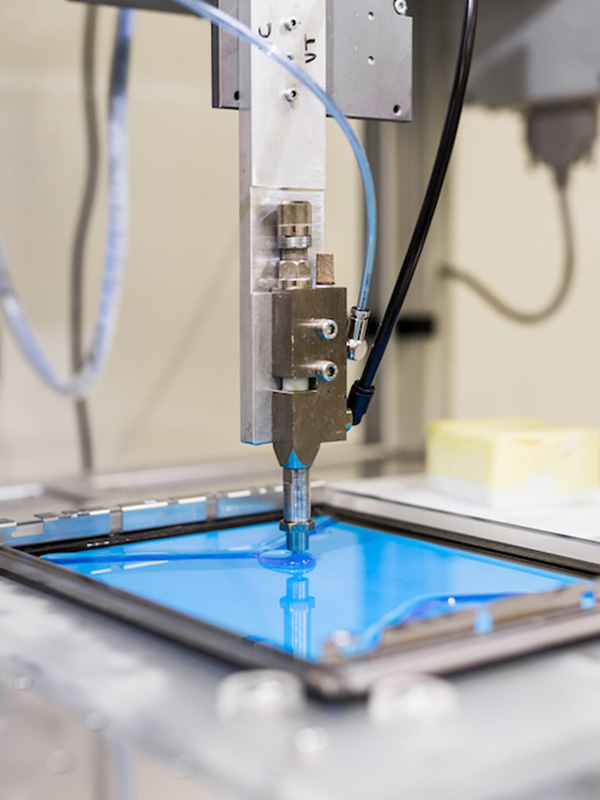
Common Mistakes When Applying Adhesive for OLED Displays
When applying adhesive for OLED displays, following the correct procedures is crucial to ensure a successful and durable bond. However, there are several everyday things that people need to correct during this process, and here are some of them:
- Insufficient Cleaning: One of the most common mistakes is inadequate cleaning of the surfaces to be bonded. Removing all dust, oils, and contaminants from the display and substrate before applying the adhesive is essential. Failure to do so can result in poor adhesion and potential display failure.
- Inaccurate Application: Applying the adhesive unevenly or in the wrong areas can lead to bonding issues and affect the overall display performance. It’s essential to follow the manufacturer’s guidelines regarding the application method, including the recommended amount, spreading technique, and curing time.
- Using the Wrong Adhesive: OLED displays require specialized adhesives for their unique properties, such as flexibility and transparency. Using a suitable adhesive can result in compatibility issues, adequate bonding strength, or damage to the display. Always ensure that the adhesive chosen is formulated explicitly for OLED applications.
- Incorrect Cure Time: Adhesive curing time is crucial for achieving optimal bonding strength. Some people rush the process by not allowing sufficient time for the adhesive to cure fully. Similarly, others may apply pressure or manipulate the display too soon, disturbing the curing process. Always adhere to the recommended curing time specified by the adhesive manufacturer.
- Overlooking Environmental Factors: Environmental conditions like temperature and humidity can significantly impact adhesive performance. Failure to consider these factors during the bonding process can lead to poor adhesion, curing issues, or even adhesive failure. Follow the adhesive manufacturer’s instructions regarding the ideal environmental conditions for application and curing.
- Neglecting Safety Precautions: Adhesives often contain chemicals that can be harmful if mishandled. Some people overlook safety precautions such as wearing gloves, protective eyewear, or working in a well-ventilated area. Always prioritize safety when handling adhesives and follow the recommended guidelines to protect yourself and others.
- Insufficient Testing and Quality Control: Before mass production or final assembly, it’s essential to conduct thorough testing and quality control measures. Some individuals may need to pay more attention to these steps, which can lead to adhesive-related issues in the finished product. Always perform appropriate tests, such as adhesion strength, thermal cycling, and reliability testing, to ensure the adhesive meets the required standards.
Avoiding these common mistakes can significantly improve the adhesive bonding process for OLED displays. Following the manufacturer’s instructions, paying attention to environmental conditions, and implementing proper safety measures will help achieve reliable and long-lasting adhesion, ensuring the quality and performance of the displays.
Maintenance and Repair of OLED Display Modules
Maintenance and repair of OLED display modules are essential to ensure optimal performance and prolong the lifespan of these advanced display technologies. OLED (Organic Light-Emitting Diode) displays are known for their superior picture quality, vibrant colors, and high contrast levels. However, OLED displays can experience issues or degradation over time, like any electronic device. Performing regular maintenance and addressing repair needs promptly can help mitigate these problems and maximize the longevity of OLED display modules.
Maintenance of OLED display modules primarily involves proper cleaning and careful handling. When cleaning an OLED display, using a soft, lint-free cloth and non-abrasive cleaning solutions specifically designed for electronic displays is crucial. Harsh chemicals or rough materials can damage the delicate surface of the OLED panel. Gently wipe the screen in a circular motion to remove dust, fingerprints, or smudges. It’s important to avoid applying excessive pressure or scratching the surface.
Additionally, it is advisable to keep OLED displays away from direct sunlight or sources of intense heat, as this can cause damage to the organic materials within the collection. OLED panels are sensitive to heat, and prolonged exposure can result in pixel burn-in or degradation of color accuracy. Similarly, extreme cold temperatures can affect OLED performance, so it is crucial to avoid subjecting the display to freezing conditions.
In the case of OLED display module issues, it is recommended to consult a qualified technician or the manufacturer’s customer support for repair. DIY repairs can be risky and may void the warranty. If the display exhibits persistent image retention or burn-in, remnants of previous images persist on the screen, and the manufacturer may provide specialized tools or software to address the issue. It’s essential to report any defects or abnormalities to ensure timely resolution promptly.
Repair may sometimes involve replacing faulty components within the OLED display module. OLED panels are intricate structures, and replacing individual pixels or subpixels is impractical. Therefore, if the display module suffers significant damage or malfunction, it may require a complete replacement. Manufacturers or authorized service centers typically offer repair or replacement services for OLED display modules, ensuring compatibility and preserving the device’s performance.
It is advisable to follow the manufacturer’s guidelines for usage and maintenance to avoid potential issues and optimize the lifespan of OLED display modules. Regular software updates provided by the manufacturer may also include optimizations and fixes for known problems, enhancing the overall performance of the OLED display.
Tips for Extending the Lifespan of OLED Display Modules
Extending the lifespan of OLED display modules is crucial to ensure their long-term performance and durability. Here are some tips to help you maximize the lifespan of your OLED displays:
- Adjust brightness settings: OLED displays are sensitive to brightness levels. High brightness settings can accelerate the degradation of organic materials. Consider lowering the brightness level to a reasonable and comfortable level to reduce wear and increase the display’s lifespan.
- Use screen savers and sleep mode: When the display is not in use, activate screen savers or utilize sleep mode. OLED shows are prone to burn-in, where static images can cause permanent damage. Screen savers help prevent static elements from staying on the screen for extended periods, minimizing the risk of burn-in.
- Avoid displaying static images: OLED displays are susceptible to burn-in when static images are shown for prolonged durations. To prevent this, avoid keeping static elements like logos, icons, or menus on the screen for extended periods. Utilize dynamic content and periodically move or refresh the displayed elements.
- Enable pixel shifting: Pixel shifting is a technique that slightly moves the position of on-screen content to prevent static images from causing burn-in. Some OLED displays have built-in pixel-shifting features that automatically move the content regularly. Enable this feature to distribute the wear evenly across the collection.
- Implement power management: OLED displays consume less power when displaying darker content since individual pixels emit light. Consider utilizing dark themes or implementing power-saving modes to reduce overall energy consumption. Lower power consumption can help extend the lifespan of the OLED display.
- Avoid exposure to direct sunlight: OLED displays are sensitive to heat, and prolonged exposure can cause damage. Position the displays away from direct sunlight and ensure proper ventilation to prevent overheating. High temperatures can accelerate the aging process of OLED materials.
- Clean the display carefully: When cleaning OLED displays, use a soft, lint-free microfiber cloth to avoid scratching the surface. Avoid applying excessive pressure or using harsh chemicals that may damage the show. Gently wipe the screen to remove dust, fingerprints, or smudges that can affect the visual quality.
- Update firmware regularly: Manufacturers often release updates to improve performance and address potential issues with OLED displays. Stay updated with the latest firmware releases and apply them as the manufacturer recommends. These updates may include optimizations that enhance the lifespan of the display.
- Store and transport carefully: If you need to store or transport OLED displays, ensure they are adequately protected from physical damage, extreme temperatures, and humidity. Use appropriate packaging and handling procedures to prevent potential harm that could impact the display’s lifespan.
- Use proper sleep timers: OLED displays can benefit from sleep timers that automatically turn off the show after a certain period of inactivity. This feature helps reduce unnecessary wear on the display when it’s not in use, increasing its lifespan.
By following these tips, you can significantly extend the lifespan of your OLED display modules, ensuring optimal performance and longevity.
Future Developments in OLED Display Module Adhesive
Developing OLED display module adhesive is an area of ongoing research and innovation. As OLED technology advances, manufacturers improve the adhesive materials used in these displays. Here are some potential future developments in OLED display module adhesive:
- Improved bonding strength: One focus of future adhesive development is to enhance the bonding strength between the various layers of the OLED display module. Stronger adhesives will ensure better adhesion and minimize the risk of delamination or separation of layers over time. This improvement will contribute to the overall durability and lifespan of OLED displays.
- Flexibility and stretchability: OLED displays are increasingly used in flexible and bendable devices such as smartphones, wearables, and curved displays. Future adhesive formulations must exhibit greater flexibility and stretchability to accommodate these bending and curving requirements. Adhesives that maintain their bond under various bending angles and repeated flexing will be essential for such applications.
- Thermal management: OLED displays can generate heat during operation, impacting performance and longevity. Future adhesive materials will focus on incorporating better thermal management properties. Adhesives with improved heat dissipation capabilities will help mitigate thermal stress on OLED displays, preventing overheating and potential damage.
- Optical transparency: OLED displays are known for their excellent visual quality and vibrant colors. Future adhesive development will aim to maintain or enhance the optical clarity of adhesives used in OLED presentations. Transparent and clear adhesives will ensure minimal interference with light transmission, allowing the OLED pixels to display accurate and vibrant colors.
- Ultra-thin and lightweight: As technology progresses, there is a continuous drive to reduce the thickness and weight of electronic devices. Future adhesive materials for OLED displays will be engineered to be ultra-thin and lightweight, minimizing the overall thickness of the display module. Thinner and lighter adhesives will contribute to the slimness and portability of devices while maintaining the required bonding strength.
- Environmental considerations: Sustainable and eco-friendly adhesive solutions, including OLED displays, are increasingly important in developing electronic devices. Future adhesive materials will likely focus on reducing or eliminating the use of hazardous substances, such as volatile organic compounds (VOCs) or heavy metals. Environmentally friendly adhesive options will meet the growing demand for greener and more sustainable electronics.
- Manufacturing efficiency: OLED displays are manufactured using complex processes involving precise alignment and bonding of multiple layers. Future adhesive developments will streamline and optimize the manufacturing process, improving efficiency and reducing production costs. Adhesives enabling faster curing times, higher yield rates, and easier handling will enhance manufacturing productivity.
- Long-term stability: Stability is a crucial factor in adhesive materials for OLED displays. Future developments will focus on creating adhesives with improved long-term stability, resistant to environmental factors such as temperature, humidity, and UV exposure. Adhesives that maintain their properties over extended periods will ensure the longevity and reliability of OLED displays.
Conclusion: OLED display modules have become an essential component of various electronic devices, and the adhesive that holds them in place is equally crucial. High-quality adhesive can improve the device’s durability, reliability, and performance. With so many types of adhesive available for OLED displays, it is essential to consider the application’s specific requirements and choose the right one. Proper application techniques and maintenance can also ensure that the OLED display module performs optimally for an extended period. By understanding the importance of OLED display module adhesive, you can make informed decisions and improve your device’s performance.



